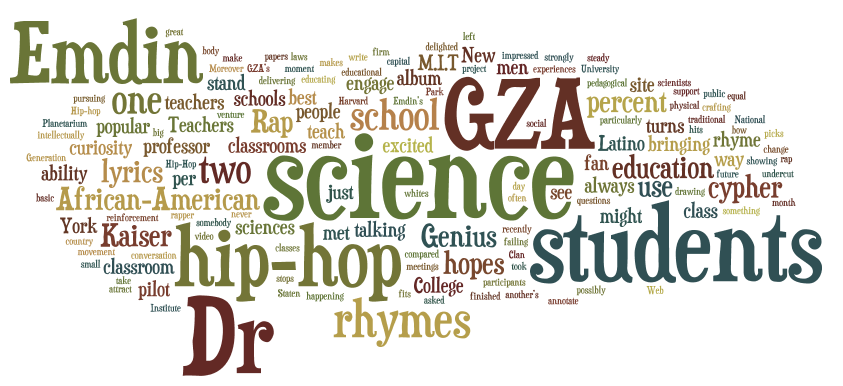Hip-Hop Culture & Science Teaching: Progressive Education in Action
I’ve written several posts on this blog about Professor Christopher Emdin, Professor of Science Education, Teachers College, Columbia University in New York City.
Dr. Emdin has worked for years in New York City schools with urban youth to help teachers change the way they work with their students to bring real meaning to the learning of science. The kind of teaching environment that Emdin suggests for urban schools is a communal one. Communal classrooms involve students and teachers working with subject matter through interactions that focus on interpersonal relationships, community and the collective betterment of the group. This type of teaching requires not only an understanding of the student’s culture, but the courage and willingness to create classrooms based on relationships, empathy, and understanding, and there is real evidence that to do this the best and most experienced teachers are needed.
Emdin provides insight for us as to go about being a teacher in urban classrooms. Because Emdin places great emphasis encouraging teachers to understand their urban students and he says this:
…it is necessary to understand how students know, feel, and experience the world by becoming familiar with where students come from and consciously immersing oneself in their culture. This immersion in student culture, even for teachers who may perceive themselves to be outsiders to hip-hop, simply requires taking the time to visit, observe, and study student culture.
Dr. Emdin suggests that classrooms should be viewed as a “space with its own reality.” In particular he urges us to focus on the “experiences of hip-hop participants as a conduit through which they can connect to science.” Using the concept “reality pedagogy” teaching in the urban classroom means creating a new dialogue where the student’s beliefs and behaviors are considered normal, and that the experiences within the hip-hop culture can actually be the way to learning science.
Dr. Emdin’s research and work with students is progressive education in action, and Emdin is doing the research to document his and his colleagues efforts. According to John Dewey, learning environments that tend to be more informal than formal use elements of non-school learning that in the end bring the students closer to the [science] curriculum, perhaps making border crossings less hazardous. In this context, learning is tied to “use, to drama of doubt, need and discovery” (Fishman and McCarthy 1989).
Emdin has brought the culture of hip-hop into the classroom to create this kind of environment. As Dewey, and now Emdin point out, in formal learning settings, scientific ideas & concepts are presented as if they were bricks, and we are tempted to try to pass out ideas, because like bricks, they are separable. Concepts are taught without a context, without connections, and without relevance to the students. Yes, there are some students who will learn science very well in formal environments. But many students, who will not benefit from such formality, thrive in informal learning environments. Working on topics of their own choice, collaborating in cooperative groups, or discussing the relevance of the content—each of these ideas will give to the informality of the classroom.
And this is the heart of Emdin’s work. In this video, Dr. Emdin explains how he integrates hip-culture, the Obama Effect, and urban science education based on his theory of communal learning.
Recently Dr. Emdin published a ground-breaking book entitled Urban Science Education for the Hip-Hop Generation. The book provides essential tools for the urban science educator and researcher, according to the publisher. But it is much more than that.
Christopher Emdin say this about the philosophy that under-girds urban science education:
In urban classroom, the culture of the school is generally different from the culture of the students. In addition, a majority of students are either African American or Latino/a while their teachers are mostly White. Culturally, urban youth are mostly immersed in a generally communal and distinctly hip-hop based way of knowing and being. By this, I mean that the shared realities that come with being socioeconomically deprived areas brings urban youth together in ways that transcend race/ethnicity and embraces their collective connections to hip-hop. Concurrently, hip-hop is falsely interpreted as being counter to the objectives of school, or seen as “outside of” school culture.
In the current conversation about educational reform, and in particular, science education reform, the thinking reflected in Emdin’s book should be fundamental reading for science teachers and teacher educators, as well the corporate types that are aggressively pushing the corporate take over of schooling which relies on a very traditional model of teaching.

Hip Hop and Science Teaching–Reform from the inside Out
In a New York Times article , Dr. Emdin was interviewed about his new project, which will target grades 9-12, and will cover sciences ranging from biology to physics. The program will use hip-hop to teach science in 10 New York City public schools. In the NYT’s article, Emdin explains the nature of the innovation which will take place starting in January 2013:
On a recent afternoon in his office at Teachers College, Dr. Emdin likened the skills required for success in science to those of a good rapper: curiosity, keen observation, an ability to use metaphor and draw connections. Moreover, he said, the medium itself provided a model that could be more effective than traditional science instruction, in which teachers stand in front of classes delivering information, then judge students by their ability to repeat it on tests.By contrast, in what is known as a hip-hop “cypher,” participants stand in a circle and take turns rapping, often supporting or playing off one another’s rhymes.
“A hip-hop cypher is the perfect pedagogical moment, where someone’s at the helm of a conversation, and then one person stops and another picks up,” Dr. Emdin said, his checked bow tie bobbing under his chin. “There’s equal turns at talking. When somebody has a great line, the whole audience makes a ‘whoo,’ which is positive reinforcement.”
The innovative approach to reform was initiated when Dr. Emdin met a famous musician. Here is how it happened:
Christopher Emdin is a Columbia University professor who likes to declaim Newton’s laws in rhyme.GZAis a member of the Wu-Tang Clan who left school in 10th grade. When the two men met this summer, at a radio show hosted by Neil deGrasse Tyson, the director of the Hayden Planetarium, they started talking about science and education — particularly, why science classrooms were failing to engage many African-American and Latino students, who together make up 70 percent of New York City’s student body.
GZA had recently completed work at MIT and Harvard to develop a solo album on the “cosmos.” The two met later. They discovered a shared interest in merging their two worlds: GZA by bringing science into hip-hop; Dr. Emdin by bringing hip-hop into the science classroom.
The project will involve ten New York City high schools. According to the New York Times article, starting in January, the 10 schools, with support from Dr. Emdin and his graduate students, will experiment with cyphers and rhymes to teach basic science concepts — one class per school, one day per week. The students will write rhymes in lieu of papers; the best rhymes, as judged by GZA, will appear on Rap Genius, beside the lyrics of popular hits. The program fits into a broader educational movement to use students’ outside interests to engage them in class work.
Dewey’s idea was to create an environment for social and pedagogical experimentation. The school was learner-centered, and the curriculum was organized as an interdisciplinary approach to education. Teachers designed activities based on a theory of growth stages, and the activities engaged students in self-development and mutual respect. Dewey advocated the idea that thinking was an active process involving experimentation and problem solving. He also espoused the idea that the school had a political role as an instrument for social change.
In our own view, Dr. Emdin has furthered Dewey’s ideas, and created a pedagogy that engages students in science using their own cultural knowledge and experience. Now, that’s reform.
What are your views on Dr. Emdin’s work in science education with urban youth?
This blog post has been shared by permission from the author.
Readers wishing to comment on the content are encouraged to do so via the link to the original post.
Find the original post here:
The views expressed by the blogger are not necessarily those of NEPC.
